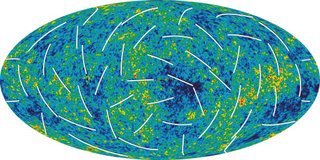Bigger things than us
 Every so often, I have to toss in a story of professional interest just to remind myself that not all the world is engaged is deadly bloodshed and the furtherance of monied interests. In fact, most of the world isn't engaged in blood-money pursuits, but news of that is hard to find because "newsmakers" generally are. Nonetheless, occasionally an interesting story pops up and mercy for that.
Every so often, I have to toss in a story of professional interest just to remind myself that not all the world is engaged is deadly bloodshed and the furtherance of monied interests. In fact, most of the world isn't engaged in blood-money pursuits, but news of that is hard to find because "newsmakers" generally are. Nonetheless, occasionally an interesting story pops up and mercy for that.In the spring of 2004, Charles Bennett's team used the Wilkinson Microwave Anisotropy Probe (WMAP) to fairly well pin down the age and size of the universe based on measurements of the Cosmic Microwave Background radiation (CMB). The age was reasonably well-determined to be 13.7 billion years. The important thing to note about this experiment is that its measurements were made at the largest scale possible.
But now, Alceste Bonanos at the Carnegie Institution claims that the universe might be 15% older and larger than the WMAP findings, placing the age at 15.8 billion years. This is a conflict and well outside the error bars of WMAP, several sigma, in fact. Bonanos used a new technique studying eclipsing binaries to calculate the distance to the galaxy M33 in our local group, which his team claims is 15% further away than had been previously thought. But herein lies what might be the problem.
Arguments about the value of the Hubble constant have been raging for quite sometime and have extended to speculate whether H is even a constant at all. Certainly, it is locally dependent upon nearby matter-energy density, something WMAP cannot and does not measure. But I suspect what we are seeing with this apparent conflict is a scale problem.
A distance measurement to M33 would be considered to be local. In fact, the motion within our local cluster is in no way representative of the large scale expansion of the universe. Bonanos may well have determined a better measurement for the distance to M33, but it seems a very large stretch indeed to claim that this means the Hubble constant is different by 15% than that determined by WMAP. Since H is dependent upon the matter-energy density, locally varying densities can produce different values of H on small scales. But then this gets into an argument of what one means by H: is it only the overall value of the expansion of the universe and does H have any meaning at smaller scales?
I'm spitting into the wind a bit here because I haven't really seen the paper yet, which comes out in the next Astrophysical Journal. That will give a better idea of just what it is Bonanos' team is laying claim to.


3 Comments:
Nice posts, Ken. Just wanted to let you know I stopped by. Lately, I've immersed myself in housing bubble and peak oil blogs, so yes, it's refreshing to hear something about astronomy. - Pete
I think I found the essay. It doesn't actually mention the age of the universe though.
http://arxiv.org/abs/astro-ph/0606279
Hi Paul,
Thanks for the link. I plowed through it quickly.
Their calculations of the distance modulus to M33,
m - M = 5log(r) -5,
is given to be 24.92 +/- 0.12 mags (pp. 14) or
964 +/- 65 kpc.
They don't mention age, per se, but on their resulting value of Ho (H-naught), which are inversely proportional.
on pp. 15, they claim,
Ho = 61 km/s/Mpc
which is far lower than the WMAP/Hubble Key Project value of ~ 71 km/s/Mpc.
They do seem to have a legimate and well-argued position that metallicity corrections and reddening in the Hubble Key project may be questionable. There may be something to this; their own photometric analysis appears rigorous:
This improbable result brings into question the Key Project metallicity corrections and reddening values not only for M33, but also for the other galaxies in the Key Project. We thus demonstrate the importance of accurately calibrating the distance scale and determining Ho, which are both vital for constraining the dark energy equation of state (Hu 2005) and complementing the cosmic microwave background measurements from the Wilkinson Anisotropy Probe (WMAP, Spergel et al. 2006).
Hmm. Maybe. I'm sure they will now commence duking it out.
Post a Comment
<< Home